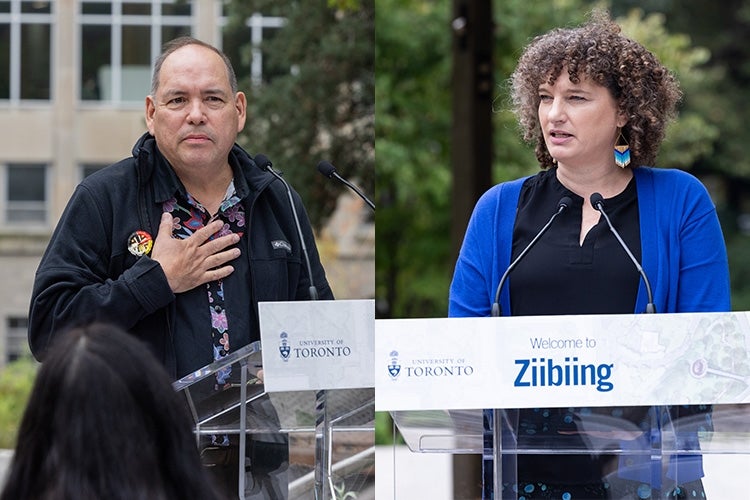In photos: U of T marks opening of Indigenous landscape project at Hart House Green

The pathway that extends along the east side of Ziibiing follows the trail of Taddle Creek, a buried stream running under the St. George campus that once served as a gathering place for Indigenous Peoples (photo by Polina Teif)
Published: September 27, 2024
The University of Toronto commemorated the official opening of Ziibiing, an Indigenous landscape project that uses architecture, horticulture and storytelling to honour Indigenous cultures and provide a space for community members to gather, learn and host ceremonies on the St. George campus.
The opening celebration for Ziibiing, held Monday Sept. 23, included a traditional Elder’s opening, a welcome song and the burning of a sacred fire – the first fire to be lit in Ziibiing’s pavilion and one of several Indigenous ceremonial practices that are welcome on all three U of T campuses.
Here’s how the event unfolded through the lens of U of T photographers:

Michael White, director of First Nations House, tends to the sacred fire in the Ziibiing pavilion as Jenny Blackbird, resource centre and programs co-ordinator at First Nations House, looks on.
Ceremonial fires, smudging and pipe ceremonies are among the important Indigenous practices that take place on U of T’s three campuses.

Blackbird performs a traditional song to welcome U of T community members to the celebration.

The vision for Ziibiing was developed by an Indigenous Advisory Committee in collaboration with the Indigenous Design Studio at Brook McIlroy, who in turn consulted with Indigenous students, faculty, staff, the Council of Indigenous Initiatives Elders' Circle and representatives of local First Nations.
The project was born out of Answering the Call: Wecheehetowin, the final report of the Steering Committee for the University of Toronto Response to the Truth and Reconciliation Commission of Canada, which outlined the need for dedicated Indigenous spaces on campus.

Several members of the U of T community spoke at the event.
“Our voices, traditions and histories are woven into the fabric of this new landscape, sending a clear signal that we are seen, that we matter and that we belong,” said Shannon Simpson, senior director of the Office of Indigenous Initiatives and a member of the Mississaugas of Alderville First Nation, in her remarks at the ceremony.

Ziibiing is named for the Anishinaabemowin word for “river,” a reference to the Taddle Creek waterway that once flowed through the area and served as a gathering place for Indigenous Peoples.
It’s an example of how Indigenous design and Western architectural disciplines can come together to assist in placemaking, according to James Bird, a Knowledge Keeper from the Nehiyawak and Dene Nation and PhD candidate in the John H. Daniels Faculty of Architecture, Landscape, and Design.
“In the practice of architecture, there are ways one can approach the creation of space and its activation through design," said Bird. “This alternative viewpoint assigns agency to the metaphysical aspects that exist within Indigenous cultures and in turn allows metaphysical relationships to be made into physical form.”

In her remarks to the event’s attendees, Kelly Hannah-Moffat, U of T’s vice-president, people strategy, equity and culture, said that, in addition to serving a vital role as a teaching and ceremonial space for Indigenous students, employees and Elders, Ziibiing will encourage the entire U of T community to “find innovative ways to Indigenize this institution.”
She noted the space has already hosted a recent land-based learning workshop that invited members of the U of T community to deepen their understanding of Indigenous world views, teachings and connections to the land. The workshop was organized by the Office of Indigenous Initiatives, with future sessions scheduled for Oct. 22 and Nov. 19.

The Ziibiing pavilion is supported by 13 columns that symbolize the 13 moons of the year. They circle a fire pit where ceremonial fires may be lit and maintained by Indigenous firekeepers.

The creation of Ziibiing took place alongside the Landmark Project, which aimed to revitalize the historic core of the St. George campus.
Scott Mabury, U of T’s vice-president, operations and real estate partnerships, said U of T community members have already embraced Ziibiing, as well as the other new spaces, as evidenced by their increased use of the reimagined landscapes.
“We didn’t know what we didn’t have before,” he said.



